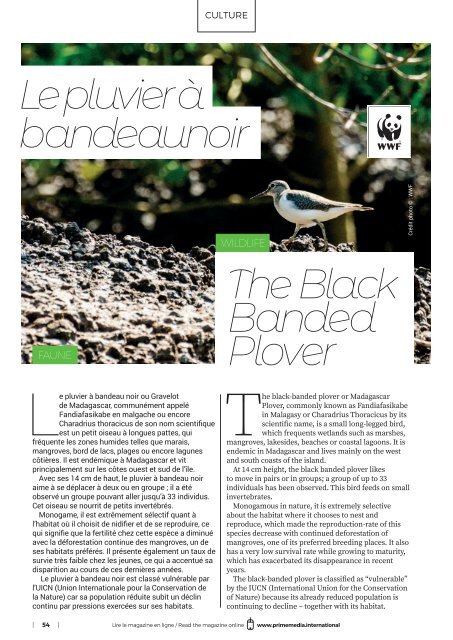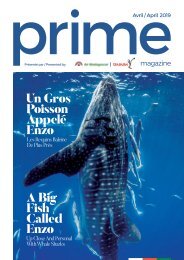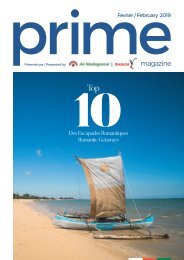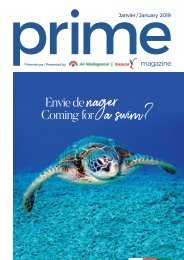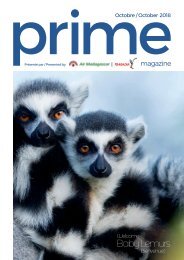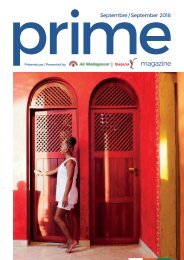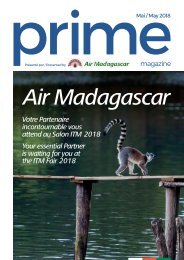PRIME MAG - AIR MAD - JULY 2018 -all- LO-RES
You also want an ePaper? Increase the reach of your titles
YUMPU automatically turns print PDFs into web optimized ePapers that Google loves.
CULTURE<br />
Le pluvier à<br />
bandeau noir<br />
WILDLIFE<br />
Crédit photo © : WWF<br />
FAUNE<br />
The Black<br />
Banded<br />
Plover<br />
Le pluvier à bandeau noir ou Gravelot<br />
de Madagascar, communément appelé<br />
Fandiafasikabe en malgache ou encore<br />
Charadrius thoracicus de son nom scientifique<br />
est un petit oiseau à longues pattes, qui<br />
fréquente les zones humides telles que marais,<br />
mangroves, bord de lacs, plages ou encore lagunes<br />
côtières. Il est endémique à Madagascar et vit<br />
principalement sur les côtes ouest et sud de l’île.<br />
Avec ses 14 cm de haut, le pluvier à bandeau noir<br />
aime à se déplacer à deux ou en groupe ; il a été<br />
observé un groupe pouvant <strong>all</strong>er jusqu’à 33 individus.<br />
Cet oiseau se nourrit de petits invertébrés.<br />
Monogame, il est extrêmement sélectif quant à<br />
l’habitat où il choisit de nidifier et de se reproduire, ce<br />
qui signifie que la fertilité chez cette espèce a diminué<br />
avec la déforestation continue des mangroves, un de<br />
ses habitats préférés. Il présente également un taux de<br />
survie très faible chez les jeunes, ce qui a accentué sa<br />
disparition au cours de ces dernières années.<br />
Le pluvier à bandeau noir est classé vulnérable par<br />
l’UICN (Union Internationale pour la Conservation de<br />
la Nature) car sa population réduite subit un déclin<br />
continu par pressions exercées sur ses habitats.<br />
The black-banded plover or Madagascar<br />
Plover, commonly known as Fandiafasikabe<br />
in Malagasy or Charadrius Thoracicus by its<br />
scientific name, is a sm<strong>all</strong> long-legged bird,<br />
which frequents wetlands such as marshes,<br />
mangroves, lakesides, beaches or coastal lagoons. It is<br />
endemic in Madagascar and lives mainly on the west<br />
and south coasts of the island.<br />
At 14 cm height, the black banded plover likes<br />
to move in pairs or in groups; a group of up to 33<br />
individuals has been observed. This bird feeds on sm<strong>all</strong><br />
invertebrates.<br />
Monogamous in nature, it is extremely selective<br />
about the habitat where it chooses to nest and<br />
reproduce, which made the reproduction-rate of this<br />
species decrease with continued deforestation of<br />
mangroves, one of its preferred breeding places. It also<br />
has a very low survival rate while growing to maturity,<br />
which has exacerbated its disappearance in recent<br />
years.<br />
The black-banded plover is classified as “vulnerable”<br />
by the IUCN (International Union for the Conservation<br />
of Nature) because its already reduced population is<br />
continuing to decline – together with its habitat.<br />
| 54 | Lire le magazine en ligne / Read the magazine online www.primemedia.international


